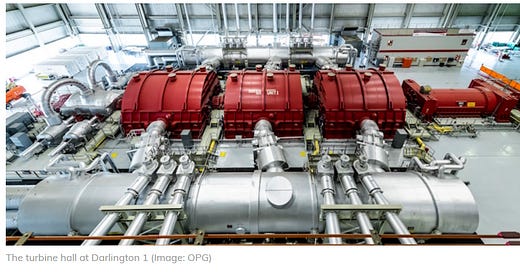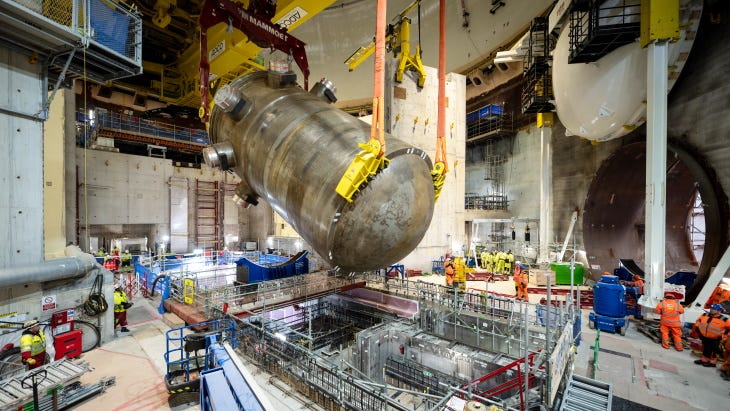The Renaissance of Nuclear Power
A bi-partisan sea shift in attitudes and the obvious solution to our need for energy
from wnn (World Nuclear News) - At Darlington 1 (photo) in Ontario, Canada, “The 875 MWe unit was taken offline for refurbishment in February 2022, following units 2 and 3, which completed refurbishment in 2020 and 2023, as part of a 10-year CAD12.8 billion (about USD9.7 billion) mega-project to refurbish all four Candu units at the site. The final unit undergoing refurbishment, unit 4, is currently in the reactor rebuilding phase, and is on schedule to be completed by the end of 2026.”
There’s a groundswell of recognition that nuclear reactor power plants, old refurbished ones, new full size ones, and possibly new advanced ones, and small modular ones, are the way to go.
Here’s the audio, but the written version has many links to sources, so consider going deeper or saving the written for later
why it’s bi-partisan
For those who think CO2 is causing global warming, nuclear power emits no CO2.
For those who want to preserve our farmland, nuclear power plants don’t take up much land - in fact, there are existing nuclear plants that have room to build more reactors on the sites they already have.
For those who don’t like to see thousands of acres used for more high voltage towers, nuclear reactors can not only be built on existing sites that have permits to add reactors - they can also be built where there used to be coal power plants, where the infrastructure for substations and power lines are also already in place.
a US study “Evaluation of Nuclear Power Plant and Coal Power Plant Sites for New Nuclear Capacity”
Table 5. NPP=nuclear power plant. The 3 columns have a spread of years representing the coal power plants scheduled closings. MWe=Megawatts of electrical power. The potential placements are the number of new reactors that could be built on the closed coal power site. This is great because the infrastructure for substations and distribution are already there.
Table 7. NPP=nuclear power plant. 4th column shows there are 13 sites that are already planning to build new nuclear reactors. In the 5th column, COL=combined construction and operating license.
For those who were worried about radioactive waste, the facts are coming out - it’s a problem that can be handled safely. In fact, advanced nuclear reactors on the drawing boards can reuse existing spent fuel and in the process, reduce the final radioactive waste tenfold. Be sure to read Zion Lights’ study “Everything I believed about nuclear waste was wrong”
For those who worry about the extra electric demand overloading the grid, SMRs (small nuclear reactors) sized for the application can be built next door to the factory, off grid. This is the way data centers and crypto mining operations are going, if they can afford it. So far, SMRs have been too expensive to be practical - but there’s hope that costs can be brought down.
“Amazon is offering almost $334 million for a multiyear feasibility study of a cluster of small modular reactors to be built at the former Hanford nuclear site in the Richland WA area…They are partnering with Energy Northwest, whose size enables it to handle a nuclear project of a few billion dollars that an individual utility would be too small to attempt…[Amazon] has tentative plans to work with X-energy to build small modular reactors across the nation by 2039 that would collectively produce 5,000 megawatts of power…Amazon’s contract with Energy Northwest is contingent on the energy company meeting milestones in 2025 and 2026. It can withdraw from the project if cost overruns or unresolvable disputes occur.”
from datacenterknowledge - “Another benefit of SMRs is that they can be placed in more locations than traditional large nuclear plants. Nuclear plants powered by SMRs can overcome the issue of grid constraints because they can be installed closer to the consumers of energy and even on-site with data centers”
the failure of wind and grid size solar
Grid size solar and wind plantations take up thousands of acres, are unsightly, need miles of new infrastructure and new substations with new transformers and inverters, and produce no power during weather crises, making our whole grid unreliable. And it’s all for nothing. When you take into account the emissions for mining and manufacturing and transporting the materials, there’s no significant reduction of CO2 or global temperatures (0.01 C doesn’t even register on my thermometer). None of the projects would be built if it weren’t for subsidies paid by a government that has no money - they have to print it, borrow it, or tax it.
Richard Lyons from the UK explains that wind and solar are so unreliable much of the time that trying to provide enough grid size battery backup would bankrupt the nation.
tons of good news - here are just a few examples
There’s a tidal wave of nuclear power projects and innovations. Globally, there are about 70 companies vying for who can make the best small modular reactors. Major nuclear power plants that had been shut down are being brought back to life. New plants are being approved and starting construction.
In somerset, England, the Hinkley Point C nuclear power plant under construction is the first new nuclear power plant in 30 years…The reactor pressure vessel (RPV) - measuring 13 metres in height and weighing 500 tonnes was successfully installed. I love the pictures of this amazing operation. Here’s one of the PTV being lowered into place:
The RPV is lowered into the reactor pit (Image: EDF Energy)
We need to catch up with China. Stu Turley’s “Energy News Beat” just posted this: “China could keep the pace of approving at least 10 new nuclear reactors over the next 10 years, a domestic industry group says, as the country has been accelerating the approval and construction of nuclear power plants over the past few years.”
At New York Climate Week 2024, 14 large U.S. banks pledged to support the tripling of nuclear capacity by 2050. (They’ll lend, but investors won’t want to borrow on a project unless it makes business sense, so no guarantee anything will happen. But at least there might be money available.)
Zion Lights reports “Germany’s largest opposition party alliance has called for an expert assessment to re-evaluate the viability of nuclear energy, with a focus on whether recently decommissioned nuclear power plants can be reactivated…Germany shut down its remaining three nuclear plants in April 2023, and there will be a federal election in autumn 2025. A time of change for Germany…”
In the UK, 4 nuclear plants that were scheduled for shutdowns are being given extensions. They’ve built so much “renewable” wind and solar that they’ve been having to import expensive LNG (liquified natural gas) to stabilize the increasingly unreliable grid. They apparently figured out that it was stupid to shut down existing nuclear plants which generate a lot more power per dollar (or British pound) than gas.
Existing plants in some cases are being granted extensions for decades more use, with upgrades.
from foronuclear “Unit 1 of Angra nuclear power plant, which is managed by Brazilian energy company Eletronuclear, has been authorised by the country's National Nuclear Energy Commission to operate to 2044. This will extend its operating time to 60 years.”
Plants that have been closed, or shut down for refurbishing, will be coming back online.
“For the first time, a shuttered nuclear power plant in the US could reopen thanks to federal support…nuclear energy could be on the verge of a renaissance as an alternative to fossil fuels.”
The DOE gave a $1.5 Billion loan to energy technology company Holtec to reopen the nuclear power plant that shut down in 2022.
“This project will bring a retired nuclear power plant back to life for the first time in American history and deliver reliable, affordable clean power to rural areas in Michigan, Wisconsin, Indiana and Illinois”
Vietnam decided to restart nuclear power plants: (another excerpt from Zion Lights)
“Vietnam has been on a journey - the country first considered nuclear power generation in 1995 and again in 2006, but in 2016, plans were shelved in favour of gas and coal. Now, the Government is amending the Law on Electricity to allow the building and operation of nuclear power plants. Earlier this month, legislators also pushed for the Ninh Thuan nuclear power plant to be restarted, and The Communist Party of Vietnam gave the proposal the go-ahead. They also have plans to build two nuclear power plants.”
I encourage you to read the entire Zion Lights post. She also mentions plans to build nuclear reactors in Malaysia, Bulgaria, Kazakhstan, Poland, the Netherlands, and Kenya.
In Belarus, “the [first nuclear] plant was reportedly completed on time and on budget. Unit 1 entered commercial operation on June 10, 2021, and Unit 2 followed on Nov. 1, 2023… Today, more than 2,700 people work at the Belarusian NPP. “The staff of the nuclear power plant has been formed, trained, and has confirmed its qualifications more than once,” the spokesperson reported.”
“The Belarusian Energy Ministry is developing a feasibility study for the construction of a third power unit at the Belarusian Nuclear Power Plant (BelNPP) or a second nuclear power plant in the country, and the work will be completed in 2025...”
There’s also progress on safely handling radioactive waste:
“Switzerland's national radioactive waste disposal cooperative Nagra has applied to the Swiss Federal Office of Energy for a general permit for the construction of the planned deep geological repository for radioactive waste and a used nuclear fuel encapsulation plant.”
The US is promoting more progress on the newest, safer than ever high temp Generation IV reactors:
“The US Nuclear Regulatory Commission (NRC) agreed to issue construction permits to Kairos Power for the Hermes 2 Demonstration Plant to be built at the Heritage Centre Industrial Park in Oak Ridge, Tennessee. Hermes 2 will build on experience from the Hermes Low-Power Demonstration Reactor, which was the first US Generation IV reactor to receive an NRC construction permit in December 2023. Kairos says Hermes 2 is now the first power-producing Gen IV plant to be approved for construction in the US.
The Hermes series represents a major step on Kairos Power’s iterative path to commercialising fluoride salt-cooled, high-temperature reactor (KP-FHR) technology. According to Kairos, Hermes 2 will demonstrate complete plant architecture at a reduced scale and supply clean electricity to the grid, further advancing technology, licensing, supply chain, and construction certainty for Kairos Power’s commercial deployments.”
Bonus - don’t forget the value of nuclear reactors for creating radioisotopes for medical diagnosis and treatments.
from the journal of nuclear medicine “…Nuclear medicine now provides diagnostic, prognostic, predictive, and intermediate endpoint biomarkers in oncology, cardiology, neurology, and infectious and inflammatory disorders…nuclear medicine includes not only diagnostic but also therapeutic applications of radioisotopes [and radionuclides]. In fact, the successes in treating benign and malignant thyroid disorders with radioiodine were the main reasons for establishing nuclear medicine as an independent medical discipline.”









A lot is going on to help with elecric power.
Dec.7th 2024 - "Unit 2 of the Shimane nuclear power plant in Japan's Shimane Prefecture was restarted... It becomes the fourteenth Japanese reactor - and the second boiling water reactor - to resume operation." (WNN) It had been offline for 13 years.